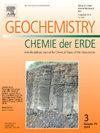利用40Ar/39Ar技术研究月球陨石的热辐射历史:Dhofar 025、309、730、733、1442、西北非洲6888和Sayh al Uhaymir 449
IF 2.9
3区 地球科学
Q2 GEOCHEMISTRY & GEOPHYSICS
引用次数: 0
摘要
我们对一组来自炎热沙漠的月球陨石进行了高分辨率的40Ar/39Ar测年:Dhofar 025、309、730、733、1442、西北非洲6888和Sayh al Uhaymir 449。通过等时线对地球和月球捕获氩成分的识别使我们能够识别原位放射性氩并获得适当的年代信息。所有研究样品的最后总重置年龄在3.1 ~ 4.2 Ga之间,与月球上强烈的陨石坑期和海火山活动同期。只有西北非洲6888在2.5亿年前被完全重置。该系列陨石中埋藏最深的角砾岩Dhofar 733年龄最老,为4.23±0.04 Ga。Dhofar 733、1442和NWA 6888受到≤1 Ga的近期撞击事件的进一步影响。所有的陨石都被月球表面的银河宇宙射线照射了几到几百毫安。在~0.5 Ma范围内,仅发现了一颗陨石的辐照历史。月球角砾岩暴露年龄、太阳氩丰度以及宇宙成因和放射性成因氩的部分损失的比较表明,长时间的表面停留增强了太阳风注入36Ar的积累,但也增强了弥漫性气体损失,这很可能是由于太阳和/或撞击加热等表面热效应造成的。表面风化角砾岩Dhofar 025、1442、NWA 6888、SaU 449含月球俘获氩,40Ar/36Ar比值为6 ~ 15,深部角砾岩Dhofar 730含(40Ar/36Ar)俘获氩比值为81。这可能表明月球陨石中被困氩的组成可能取决于岩石的分层深度。我们认为气体的最终捕获发生在烧结和沿着晶界的凝聚过程中,这是由伴随冲击诱导的压实的热过程引起的。Dhofar 1442含有两种不同的月球捕获氩成分,(40Ar/36Ar)捕获比分别为14.58±0.28和5.5±0.7,表明月球陨石可能含有不止一种在不同热事件中合并的外星捕获成分。我们新的月球陨石40Ar/39Ar年龄显著增加了高分辨率高原年龄谱的数量,为3.9 Ga前的地质年代学提供了更有说服力的证据。与阿波罗号样品相比,其不同的年龄分布可能与月球陨石提供了更随机、更完整的月球表面样本有关,包括更古老的大盆地的喷出物,因此更倾向于更连续或偶发性的3.9 Ga前轰击情景。一种可能导致偶发性小天体扰动和轰击的情况是,在太阳生命的最初几亿年里,太阳所在的大质量星团内发生了近距离的恒星碰撞。本文章由计算机程序翻译,如有差异,请以英文原文为准。
Thermal and irradiation history of lunar meteorites by the 40Ar/39Ar technique: Dhofar 025, 309, 730, 733, 1442, Northwest Africa 6888, and Sayh al Uhaymir 449
We performed high-resolution 40Ar/39Ar dating of a suite of lunar meteorites from hot deserts: Dhofar 025, 309, 730, 733, 1442, Northwest Africa 6888, and Sayh al Uhaymir 449. The identification of terrestrial and lunar trapped argon components via isochrons allowed us to identify in situ radiogenic argon and to obtain proper chronological information. The last total reset ages of all studied samples are in the range of 3.1 to 4.2 Ga, coeval with the intense cratering period on the Moon and mare volcanism. Only Northwest Africa 6888 was totally reset <2.5 Ga ago. The most deeply buried breccia Dhofar 733 has the oldest age of 4.23 ± 0.04 Ga within this series of meteorites. Dhofar 733, 1442, and NWA 6888 were furthermore affected by recent impact events ≤1 Ga. All meteorites were irradiated by galactic cosmic rays on the surface of the Moon for several up to hundreds of Ma. A simple irradiation history is revealed for only one meteorite Dhofar 733 delivered to Earth within ~0.5 Ma. The comparison of exposure ages, solar argon abundances and partial loss of cosmogenic and radiogenic argon of lunar breccias indicates that long surface residence enhances accumulation of solar wind implanted 36Ar but also diffusive gas loss, most likely by surface thermal effects as solar and/or impact heating.
The surficial regolith breccias Dhofar 025, 1442, NWA 6888, SaU 449 contain lunar trapped argon with 40Ar/36Ar ratios varying from 6 to 15, while the deep-derived breccia Dhofar 730 contains argon with (40Ar/36Ar)trapped ratio of 81. This could indicate that the composition of trapped argon in lunar meteorites may depend on rock layering depth. We suggest that the final capture of gases happens during sintering and agglutination along grain boundaries caused by thermal processes accompanying shock-induced compaction. Dhofar 1442 contains two distinct lunar trapped argon components with (40Ar/36Ar)trapped ratios of 14.58 ± 0.28 and 5.5 ± 0.7 indicating that lunar meteorites may contain more than one extraterrestrial trapped component incorporated during different thermal events.
Our new 40Ar/39Ar ages of lunar meteorites significantly increase the number of high- resolution plateau age spectra, providing more compelling evidence of geochronologically meaningful pre 3.9 Ga ages. The different age distribution when compared to Apollo samples that were frequently dominated by Imbrium ejecta may be related to the fact that lunar meteorites provide a more random and thus complete sampling of the lunar surface, encompassing ejecta of older large basins, thereby favoring scenarios of more continuous or episodic pre 3.9 Ga bombardments. A possible scenario leading to episodic small body disturbances and bombardments involves close stellar encounters within the massive stellar cluster in which the sun resided during the first hundreds of million years of its lifetime.
求助全文
通过发布文献求助,成功后即可免费获取论文全文。
去求助
来源期刊

Chemie Der Erde-Geochemistry
地学-地球化学与地球物理
CiteScore
7.10
自引率
0.00%
发文量
40
审稿时长
3.0 months
期刊介绍:
GEOCHEMISTRY was founded as Chemie der Erde 1914 in Jena, and, hence, is one of the oldest journals for geochemistry-related topics.
GEOCHEMISTRY (formerly Chemie der Erde / Geochemistry) publishes original research papers, short communications, reviews of selected topics, and high-class invited review articles addressed at broad geosciences audience. Publications dealing with interdisciplinary questions are particularly welcome. Young scientists are especially encouraged to submit their work. Contributions will be published exclusively in English. The journal, through very personalized consultation and its worldwide distribution, offers entry into the world of international scientific communication, and promotes interdisciplinary discussion on chemical problems in a broad spectrum of geosciences.
The following topics are covered by the expertise of the members of the editorial board (see below):
-cosmochemistry, meteoritics-
igneous, metamorphic, and sedimentary petrology-
volcanology-
low & high temperature geochemistry-
experimental - theoretical - field related studies-
mineralogy - crystallography-
environmental geosciences-
archaeometry
 求助内容:
求助内容: 应助结果提醒方式:
应助结果提醒方式:


